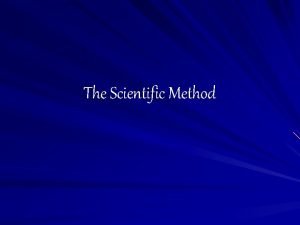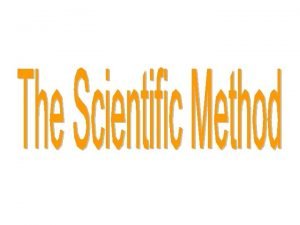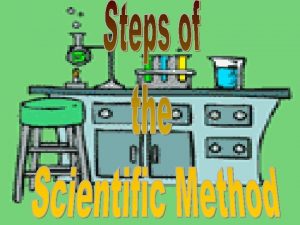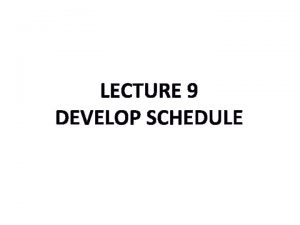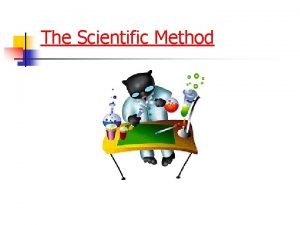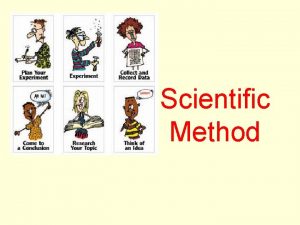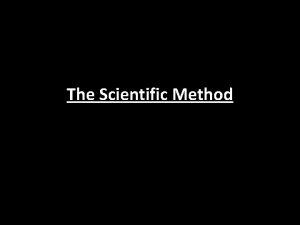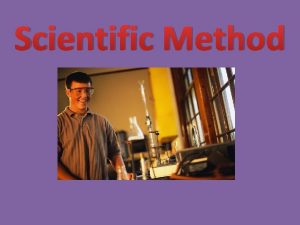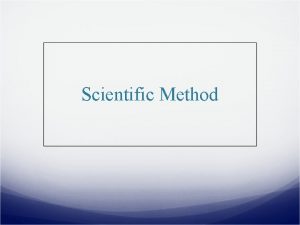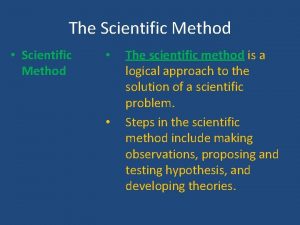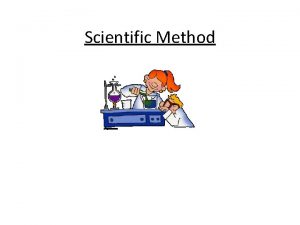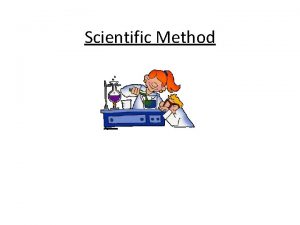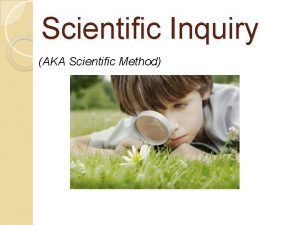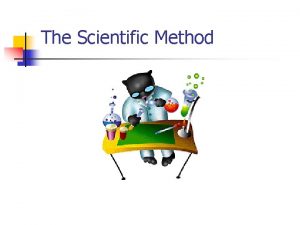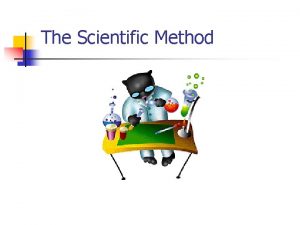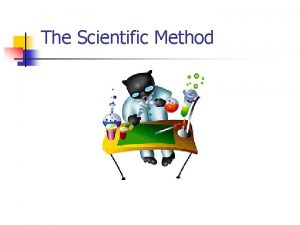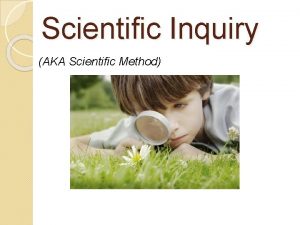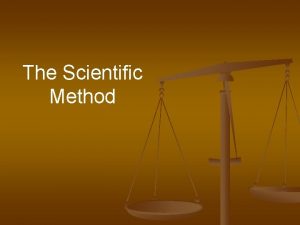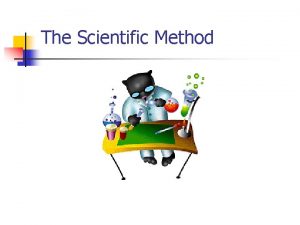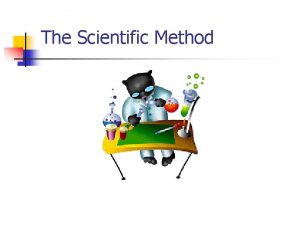Scientific Method 1 2 The Scientific Method involves



















































- Slides: 51

Scientific Method 1

2

The Scientific Method involves a series of steps that are used to investigate a natural occurrence.

We shall take a closer look at these steps and the terminology you will need to understand before you start a science project or experiment

Steps of the Scientific Method 1. Problem/Question: Problem/Question Develop a question or problem that can be solved through experimentation.

Steps of the Scientific Method 2. Observation/Research: Observation/Research Make observations and research your topic of interest.

Steps of the Scientific Method 3. Formulate a Hypothesis: Hypothesis Predict a possible answer to the problem or question. Must be TESTABLE. Example: If soil temperatures rise, then plant growth will increase.

Steps of the Scientific Method 4. Experiment: Experiment Develop and follow a procedure. Include a detailed materials list. The outcome must be measurable (quantifiable).

Control Group In a scientific experiment, the control is the group that serves as the standard of comparison. The control group may be a “no treatment" or an “experimenter selected” group.

Control Group The control group is exposed to the same conditions as the experimental group, except for the variable being tested. All experiments should have a control group.

Steps of the Scientific Method 4. Experiment The experimental group is exposed to changing values for the variable being tested. 11

Do you know the difference between the independent and dependent variables?

Independent Variable The independent, or manipulated variable, is a factor that’s intentionally varied by the experimenter.

Dependent Variable The dependent, or responding variable, is the factor that may change as a result of changes made in the independent variable.

Constants The constants in an experiment are all the factors that the experimenter attempts to keep the same.

Constants We keep all other factors the same so that any observed changes can be attributed to the variable being tested.

Steps of the Scientific Method 5. Collect and Analyze Results: Results Modify the procedure if needed. Confirm the results by retesting. Include tables, graphs, and photographs.

Steps of the Scientific Method 6. Conclusion: Conclusion Include a statement that accepts or rejects the hypothesis. Make recommendations for further study and possible improvements to the procedure.

Steps of the Scientific Method 7. Communicate the Results: Results Be prepared to present the project to an audience. Expect questions from the audience.

Think you can name all seven steps? Collect Formulate Communicate Observation/Research Problem/Question and Conclusion Experiment Analyze a Hypothesis the Results

Writeup Heading (5 pts) Abstract (10 pts) Methodology (15 pts) Theory (20 pts) Data (20 pts) Conclusion (20 pts) Format (10 pts)

Let’s put our knowledge of the Scientific Method to a realistic example that includes some of the terms you’ll be needing to use and understand.

Problem/Question John watches his grandmother bake bread. He ask his grandmother what makes the bread rise. She explains that yeast releases a gas as it feeds on sugar.

Problem/Question John wonders if the amount of sugar used in the recipe will affect the size of the bread loaf?

Caution! Be careful how you use effect and affect. Effect is usually a noun and affect, a verb. “ The effect of sugar amounts on the rising of bread. ” “How does sugar affect the rising of bread? ”

Observation/Research John researches the areas of baking and fermentation and tries to come up with a way to test his question. He keeps all of his information on this topic in a journal.

Formulate a Hypothesis After talking with his teacher and conducting further research, he comes up with a hypothesis. “If more sugar is added, then the bread will rise higher. ”

Hypothesis The hypothesis is a possible explanation about the relationship between the independent and dependent variables.

Can you think of all variables and constants for this experiment?

Constants They might include: Other ingredients to the bread recipe, oven used, rise time, brand of ingredients, cooking time, type of pan used, air temperature and humidity where the bread was rising, oven temperature, age of the yeast…

Experiment John writes out his procedure for his experiment along with a materials list in his journal. He has both of these checked by his teacher where she checks for any safety concerns.

Trials refer to replicate groups that are exposed to the same conditions in an experiment. John is going to test each sugar variable 3 times.

Collect and Analyze Results John comes up with a table he can use to record his data. John gets all his materials together and carries out his experiment.

Size of Baked Bread (Lx. Wx. H) cm 3 Size of Bread Loaf (cm 3) Trials Amt. of Sugar (g. ) 1 2 3 Average Size (cm 3) 25 768 744 761 758 50 1296 1188 1296 1260 1188 1080 1116 672 576 588 612 432 504 360 432 Contr 100 ol 250 group 500

Collect and Analyze Results John examines his data and notices that his control worked the best in this experiment, but not significantly better than 100 g. of sugar.

Conclusion John rejects his hypothesis, but decides to re-test using sugar amounts between 50 g. and 100 g.

Experiment Once again, John gathers his materials and carries out his experiment. Here are the results.

Can you tell which group did the best?

Size of Baked Bread (Lx. Wx. H) cm 3 Size of Bread Loaf (cm 3) Trials Amt. of Sugar (g. ) 1 2 3 Average Size (cm 3) 50 1296 1440 1296 1344 1404 1296 1440 1380 1638 1560 1612 80 1404 1296 1332 90 1080 1200 972 1084 Contr 60 ol 70 group

Conclusion John finds that 70 g. of sugar produces the largest loaf. His hypothesis is accepted.

Communicate the Results John tells his grandmother about his findings and prepares to present his project in Science class.

42

Precision & Accuracy 43

Measurements are taken in nearly every lab, but no measurement is perfect. There are two factors: Accuracy Precision

Types of Errors made in Lab: Human Method Instrument

Accuracy • The degree of closeness of a measured or calculated quantity to its actual (true) value. 46

Precision • The degree to which 47 further measurements or calculations show the same or similar results. Precision describes the limitation of the measuring instrument Significant figures help keep track of imprecision.

Let’s Practice You have a known mass of 10. grams. You weigh it on a scale three times. The three readings were: 10. 1 g 9. 9 g 10. 0 g Is the scale accurate, precise, both or neither? 48 Both

Let’s Practice You have a known mass of 10. grams. You weigh it on a scale three times. The three readings were 8. 1 g 7. 9 g 8. 2 g Is the scale accurate, precise, both or neither? 49 Precise

Let’s Practice You perform an experiment exactly the same three times to obtain a percentage of copper from ore. According to your calculations, you should have extracted 5. 0 g of copper. The following is how much copper you actually extracted. 2. 0 g 7. 9 g 3. 2 g Were you accurate, precise, both or Neither neither? 50

51
 Scientific method involves
Scientific method involves The first step in the scientific method involves
The first step in the scientific method involves The scientific method involves
The scientific method involves Information gathered during an experiment
Information gathered during an experiment Uses of size separation
Uses of size separation The fast tracking method of schedule compression involves
The fast tracking method of schedule compression involves Hình ảnh bộ gõ cơ thể búng tay
Hình ảnh bộ gõ cơ thể búng tay Bổ thể
Bổ thể Tỉ lệ cơ thể trẻ em
Tỉ lệ cơ thể trẻ em Gấu đi như thế nào
Gấu đi như thế nào Chụp phim tư thế worms-breton
Chụp phim tư thế worms-breton Chúa yêu trần thế
Chúa yêu trần thế Các môn thể thao bắt đầu bằng tiếng nhảy
Các môn thể thao bắt đầu bằng tiếng nhảy Thế nào là hệ số cao nhất
Thế nào là hệ số cao nhất Các châu lục và đại dương trên thế giới
Các châu lục và đại dương trên thế giới Công của trọng lực
Công của trọng lực Trời xanh đây là của chúng ta thể thơ
Trời xanh đây là của chúng ta thể thơ Mật thư anh em như thể tay chân
Mật thư anh em như thể tay chân Phép trừ bù
Phép trừ bù độ dài liên kết
độ dài liên kết Các châu lục và đại dương trên thế giới
Các châu lục và đại dương trên thế giới Thể thơ truyền thống
Thể thơ truyền thống Quá trình desamine hóa có thể tạo ra
Quá trình desamine hóa có thể tạo ra Một số thể thơ truyền thống
Một số thể thơ truyền thống Cái miệng xinh xinh thế chỉ nói điều hay thôi
Cái miệng xinh xinh thế chỉ nói điều hay thôi Vẽ hình chiếu vuông góc của vật thể sau
Vẽ hình chiếu vuông góc của vật thể sau Biện pháp chống mỏi cơ
Biện pháp chống mỏi cơ đặc điểm cơ thể của người tối cổ
đặc điểm cơ thể của người tối cổ V cc cc
V cc cc Vẽ hình chiếu đứng bằng cạnh của vật thể
Vẽ hình chiếu đứng bằng cạnh của vật thể Fecboak
Fecboak Thẻ vin
Thẻ vin đại từ thay thế
đại từ thay thế điện thế nghỉ
điện thế nghỉ Tư thế ngồi viết
Tư thế ngồi viết Diễn thế sinh thái là
Diễn thế sinh thái là Các loại đột biến cấu trúc nhiễm sắc thể
Các loại đột biến cấu trúc nhiễm sắc thể Số nguyên là gì
Số nguyên là gì Tư thế ngồi viết
Tư thế ngồi viết Lời thề hippocrates
Lời thề hippocrates Thiếu nhi thế giới liên hoan
Thiếu nhi thế giới liên hoan ưu thế lai là gì
ưu thế lai là gì Khi nào hổ con có thể sống độc lập
Khi nào hổ con có thể sống độc lập Khi nào hổ con có thể sống độc lập
Khi nào hổ con có thể sống độc lập Hệ hô hấp
Hệ hô hấp Từ ngữ thể hiện lòng nhân hậu
Từ ngữ thể hiện lòng nhân hậu Thế nào là mạng điện lắp đặt kiểu nổi
Thế nào là mạng điện lắp đặt kiểu nổi How is a scientific law different from a scientific theory?
How is a scientific law different from a scientific theory? Symposium technique
Symposium technique 7 steps of the scientific method
7 steps of the scientific method 7 steps of the scientific method
7 steps of the scientific method
